An 1846 painting of the 1773 Boston Tea Party.The Boston Tea Party in 1773 was a direct action by activists in the town of Boston to protest against the new tax on tea. Parliament quickly responded the next year with the Intolerable Acts, stripping Massachusetts of its historic right of self-government and putting it under military rule, which sparked outrage and resistance in all thirteen colonies. Patriot leaders from every colony convened the First Continental Congress to coordinate their resistance to the Intolerable Acts. The Congress called for a boycott of British trade, published a list of rights and grievances, and petitioned the king to rectify those grievances.[36] This appeal to the Crown had no effect, though, and so the Second Continental Congress was convened in 1775 to organize the defense of the colonies against the British Army.
Common people became insurgents against the British even though they were unfamiliar with the ideological rationales being offered. They held very strongly a sense of "rights" that they felt the British were deliberately violating – rights that stressed local autonomy, fair dealing, and government by consent. They were highly sensitive to the issue of tyranny, which they saw manifested by the arrival in Boston of the British Army to punish the Bostonians. This heightened their sense of violated rights, leading to rage and demands for revenge, and they had faith that God was on their side.[37]
American Revolution[edit]
The American Revolutionary War began at Lexington and Concord in Massachusetts in April 1775 when the British tried to seize ammunition supplies and arrest the Patriot leaders. In terms of political values, the Americans were largely united on a concept called Republicanism, which rejected aristocracy and emphasized civic duty and a fear of corruption. For the Founding Fathers, according to one team of historians, "republicanism represented more than a particular form of government. It was a way of life, a core ideology, an uncompromising commitment to liberty, and a total rejection of aristocracy."[38]
The Thirteen Colonies began a rebellion against British rule in 1775 and proclaimed their independence in 1776 as the United States of America. In the American Revolutionary War (1775–83) the Americans captured the British invasion army at Saratoga in 1777, secured the Northeast and encouraged the French to make a military alliance with the United States. France brought in Spain and the Netherlands, thus balancing the military and naval forces on each side as Britain had no allies.[39]
George Washington[edit]
General George Washington (1732–99) proved an excellent organizer and administrator who worked successfully with Congress and the state governors, selecting and mentoring his senior officers, supporting and training his troops, and maintaining an idealistic Republican Army. His biggest challenge was logistics, since neither Congress nor the states had the funding to provide adequately for the equipment, munitions, clothing, paychecks, or even the food supply of the soldiers.
As a battlefield tactician, Washington was often outmaneuvered by his British counterparts. As a strategist, however, he had a better idea of how to win the war than they did. The British sent four invasion armies. Washington's strategy forced the first army out of Boston in 1776, and was responsible for the surrender of the second and third armies at Saratoga (1777) and Yorktown (1781). He limited the British control to New York City and a few places while keeping Patriot control of the great majority of the population.[40]
Loyalists and Britain[edit]
The Loyalists, whom the British counted upon too heavily, comprised about 20% of the population but never were well organized. As the war ended, Washington watched proudly as the final British army quietly sailed out of New York City in November 1783, taking the Loyalist leadership with them. Washington astonished the world when, instead of seizing power for himself, he retired quietly to his farm in Virginia.[40] Political scientist Seymour Martin Lipset observes, "The United States was the first major colony successfully to revolt against colonial rule. In this sense, it was the first 'new nation'."[41]
The Declaration of Independence[edit]
On July 2, 1776, the Second Continental Congress, meeting in Philadelphia, declared the independence of the colonies by adopting the resolution from Richard Henry Lee, that stated:
That these United Colonies are, and of right ought to be, free and independent States, that they are absolved from all allegiance to the British Crown, and that all political connection between them and the State of Great Britain is, and ought to be, totally dissolved; that measures should be immediately taken for procuring the assistance of foreign powers, and a Confederation be formed to bind the colonies more closely together.
On July 4, 1776 they adopted the Declaration of Independence and this date is celebrated as the nation's birthday. On September 9 of that year, Congress officially changed the nation's name to the United States of America. Until this point, the nation was known as the "United Colonies of America"[42]
The new nation was founded on Enlightenment ideals of liberalism and what Thomas Jefferson called the unalienable rights to "life, liberty and the pursuit of happiness". It was dedicated strongly to republican principles, which emphasized that people are sovereign (not hereditary kings), demanded civic duty, feared corruption, and rejected any aristocracy.[43]
Early years of the republic[edit]
Confederation and Constitution[edit]
Reading of the United States Constitution of 1787

Economic growth in America per capita income. Index with 1700 set as 100.
In the 1780s the national government was able to settle the issue of the western regions of the young United States, which were ceded by the states to Congress and became territories. With the migration of settlers to the Northwest, soon they became states. Nationalists worried that the new nation was too fragile to withstand an international war, or even internal revolts such as the Shays' Rebellion of 1786 in Massachusetts.[44]
Nationalists – most of them war veterans – organized in every state and convinced Congress to call the Philadelphia Convention in 1787. The delegates from every state wrote a new Constitution that created a much more powerful and efficient central government, one with a strong president, and powers of taxation. The new government reflected the prevailing republican ideals of guarantees of individual liberty and of constraining the power of government through a system of separation of powers.[44]
The Congress was given authority to ban the international slave trade after 20 years (which it did in 1807). A compromise gave the South Congressional apportionment out of proportion to its free population by allowing it to include three-fifths of the number of slaves in each state's total population. This provision increased the political power of southern representatives in Congress, especially as slavery was extended into the Deep South through removal of Native Americans and transportation of slaves by an extensive domestic trade.
To assuage the Anti-Federalists who feared a too-powerful national government, the nation adopted the United States Bill of Rights in 1791. Comprising the first ten amendments of the Constitution, it guaranteed individual liberties such as freedom of speech and religious practice, jury trials, and stated that citizens and states had reserved rights (which were not specified).[45]
President George Washington[edit]
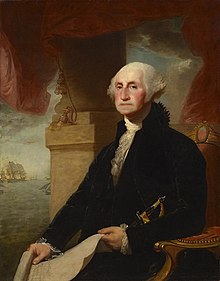
George Washington legacy remains among the two or three greatest in American history, as Commander-in-Chief of the Continental Army, hero of the Revolution, and the first President of the United States.
George Washington – a renowned hero of the American Revolutionary War, commander-in-chief of the Continental Army, and president of the Constitutional Convention – became the first President of the United States under the new Constitution in 1789. The national capital moved from New York to Philadelphia in 1790 and finally settled in Washington DC in 1800.
The major accomplishments of the Washington Administration were creating a strong national government that was recognized without question by all Americans.[46] His government, following the vigorous leadership of Treasury Secretary Alexander Hamilton, assumed the debts of the states (the debt holders received federal bonds), created the Bank of the United States to stabilize the financial system, and set up a uniform system of tariffs (taxes on imports) and other taxes to pay off the debt and provide a financial infrastructure. To support his programs Hamilton created a new political party – the first in the world based on voters – the Federalist Party.
Two-party system[edit]
Thomas Jefferson and James Madison formed an opposition Republican Party (usually called the Democratic-Republican Party by political scientists). Hamilton and Washington presented the country in 1794 with the Jay Treaty that reestablished good relations with Britain. The Jeffersonians vehemently protested, and the voters aligned behind one party or the other, thus setting up the First Party System.
Federalists promoted business, financial and commercial interests and wanted more trade with Britain. Republicans accused the Federalists of plans to establish a monarchy, turn the rich into a ruling class, and making the United States a pawn of the British.[47] The treaty passed, but politics became intensely heated.[48]
Challenges to the federal government[edit]
Serious challenges to the new federal government included the Northwest Indian War, the ongoing Cherokee–American wars, and the 1794 Whiskey Rebellion, in which western settlers protested against a federal tax on liquor. Washington called out the state militia and personally led an army against the settlers, as the insurgents melted away and the power of the national government was firmly established.[49]
Washington refused to serve more than two terms – setting a precedent – and in his famous farewell address, he extolled the benefits of federal government and importance of ethics and morality while warning against foreign alliances and the formation of political parties.[50]
John Adams, a Federalist, defeated Jefferson in the 1796 election. War loomed with France and the Federalists used the opportunity to try to silence the Republicans with the Alien and Sedition Acts, build up a large army with Hamilton at the head, and prepare for a French invasion. However, the Federalists became divided after Adams sent a successful peace mission to France that ended the Quasi-War of 1798.[47][51]
Increasing demand for slave labor[edit]
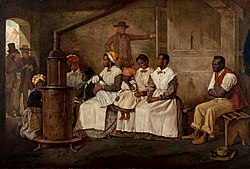
Slaves Waiting for Sale: Richmond, Virginia. Painted upon the sketch of 1853
During the first two decades after the Revolutionary War, there were dramatic changes in the status of slavery among the states and an increase in the number of freed blacks. Inspired by revolutionary ideals of the equality of men and influenced by their lesser economic reliance on slavery, northern states abolished slavery.
States of the Upper South made manumission easier, resulting in an increase in the proportion of free blacks in the Upper South (as a percentage of the total non-white population) from less than one percent in 1792 to more than 10 percent by 1810. By that date, a total of 13.5 percent of all blacks in the United States were free.[52] After that date, with the demand for slaves on the rise because of the Deep South's expanding cotton cultivation, the number of manumissions declined sharply; and an internal U.S. slave trade became an important source of wealth for many planters and traders.
In 1807, Congress severed the US's involvement with the Atlantic slave trade.[53]
Louisiana and Republicanism under Jefferson[edit]

Jefferson saw himself as a man of the frontier and a scientist; he was keenly interested in expanding and exploring the West.
Jefferson's major achievement as president was the Louisiana Purchase in 1803, which provided U.S. settlers with vast potential for expansion west of the Mississippi River.[54]
Jefferson, a scientist himself, supported expeditions to explore and map the new domain, most notably the Lewis and Clark Expedition.[55] Jefferson believed deeply in republicanism and argued it should be based on the independent yeoman farmer and planter; he distrusted cities, factories and banks. He also distrusted the federal government and judges, and tried to weaken the judiciary. However he met his match in John Marshall, a Federalist from Virginia. Although the Constitution specified a Supreme Court, its functions were vague until Marshall, the Chief Justice (1801–35), defined them, especially the power to overturn acts of Congress or states that violated the Constitution, first enunciated in 1803 in Marbury v. Madison.[56]
War of 1812[edit]
Thomas Jefferson defeated Adams for the presidency in the 1800 election. Americans were increasingly angry at the British violation of American ships' neutral rights to hurt France, the impressment (seizure) of 10,000 American sailors needed by the Royal Navy to fight Napoleon, and British support for hostile Indians attacking American settlers in the Midwest. They may also have desired to annex all or part of British North America.[59][60][61] Despite strong opposition from the Northeast, especially from Federalists who did not want to disrupt trade with Britain, Congress declared war on June 18, 1812.[62]
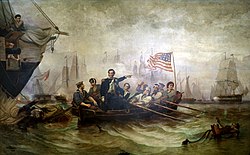
Oliver Hazard Perry's message to William Henry Harrison after the Battle of Lake Erie began with what would become one of the most famous sentences in American military history: "We have met the enemy and they are ours".
[63] This 1865 painting by William H. Powell shows Perry transferring to a different ship during the battle.
The war was frustrating for both sides. Both sides tried to invade the other and were repulsed. The American high command remained incompetent until the last year. The American militia proved ineffective because the soldiers were reluctant to leave home and efforts to invade Canada repeatedly failed. The British blockade ruined American commerce, bankrupted the Treasury, and further angered New Englanders, who smuggled supplies to Britain. The Americans under General William Henry Harrison finally gained naval control of Lake Erie and defeated the Indians under Tecumseh in Canada,[64] while Andrew Jackson ended the Indian threat in the Southeast. The Indian threat to expansion into the Midwest was permanently ended. The British invaded and occupied much of Maine.
The British raided and burned Washington, but were repelled at Baltimore in 1814 – where the "Star Spangled Banner" was written to celebrate the American success. In upstate New York a major British invasion of New York State was turned back. Finally in early 1815 Andrew Jackson decisively defeated a major British invasion at the Battle of New Orleans, making him the most famous war hero.[65]
With Napoleon (apparently) gone, the causes of the war had evaporated and both sides agreed to a peace that left the prewar boundaries intact. Americans claimed victory on February 18, 1815 as news came almost simultaneously of Jackson's victory of New Orleans and the peace treaty that left the prewar boundaries in place. Americans swelled with pride at success in the "second war of independence"; the naysayers of the antiwar Federalist Party were put to shame and the party never recovered. The Indians were the big losers; they never gained the independent nationhood Britain had promised and no longer posed a serious threat as settlers poured into the Midwest.[65]
Second Great Awakening[edit]

A drawing of a Protestant camp meeting, 1829.
The Second Great Awakening was a Protestant revival movement that affected the entire nation during the early 19th century and led to rapid church growth. The movement began around 1790, gained momentum by 1800, and, after 1820 membership rose rapidly among Baptist and Methodist congregations, whose preachers led the movement. It was past its peak by the 1840s.[66]
It enrolled millions of new members in existing evangelical denominations and led to the formation of new denominations. Many converts believed that the Awakening heralded a new millennial age. The Second Great Awakening stimulated the establishment of many reform movements – including abolitionism and temperance designed to remove the evils of society before the anticipated Second Coming of Jesus Christ.[67]
Era of Good Feelings[edit]
As strong opponents of the war, the Federalists held the Hartford Convention in 1814 that hinted at disunion. National euphoria after the victory at New Orleans ruined the prestige of the Federalists and they no longer played a significant role as a political party.[68] President Madison and most Republicans realized they were foolish to let the Bank of the United States close down, for its absence greatly hindered the financing of the war. So, with the assistance of foreign bankers, they chartered the Second Bank of the United States in 1816.[69][70]
The Republicans also imposed tariffs designed to protect the infant industries that had been created when Britain was blockading the U.S. With the collapse of the Federalists as a party, the adoption of many Federalist principles by the Republicans, and the systematic policy of President James Monroe in his two terms (1817–25) to downplay partisanship, the nation entered an Era of Good Feelings, with far less partisanship than before (or after), and closed out the First Party System.[69][70]
The Monroe Doctrine, expressed in 1823, proclaimed the United States' opinion that European powers should no longer colonize or interfere in the Americas. This was a defining moment in the foreign policy of the United States. The Monroe Doctrine was adopted in response to American and British fears over Russian and French expansion into the Western Hemisphere.[71]
In 1832, President Andrew Jackson, 7th President of the United States, ran for a second term under the slogan "Jackson and no bank" and did not renew the charter of the Second Bank of the United States of America, ending the Bank in 1836.[72] Jackson was convinced that central banking was used by the elite to take advantage of the average American, and instead implemented state banks, popularly known as "pet banks".[72]
Westward expansion[edit]
Indian removal[edit]
In 1830, Congress passed the Indian Removal Act, which authorized the president to negotiate treaties that exchanged Native American tribal lands in the eastern states for lands west of the Mississippi River.[73] Its goal was primarily to remove Native Americans, including the Five Civilized Tribes, from the American Southeast; they occupied land that settlers wanted. Jacksonian Democrats demanded the forcible removal of native populations who refused to acknowledge state laws to reservations in the West; Whigs and religious leaders opposed the move as inhumane. Thousands of deaths resulted from the relocations, as seen in the Cherokee Trail of Tears.[74] The Trail of Tears resulted in approximately 2,000–8,000 of the 16,543 relocated Cherokee perishing along the way.[76] Many of the Seminole Indians in Florida refused to move west; they fought the Army for years in the Seminole Wars.
Second Party System[edit]
After the First Party System of Federalists and Republicans withered away in the 1820s, the stage was set for the emergence of a new party system based on well organized local parties that appealed for the votes of (almost) all adult white men. The former Jeffersonian (Democratic-Republican) party split into factions. They split over the choice of a successor to President James Monroe, and the party faction that supported many of the old Jeffersonian principles, led by Andrew Jackson and Martin Van Buren, became the Democratic Party. As Norton explains the transformation in 1828:
Jacksonians believed the people's will had finally prevailed. Through a lavishly financed coalition of state parties, political leaders, and newspaper editors, a popular movement had elected the president. The Democrats became the nation's first well-organized national party, and tight party organization became the hallmark of nineteenth-century American politics.[77]
Opposing factions led by Henry Clay helped form the Whig Party. The Democratic Party had a small but decisive advantage over the Whigs until the 1850s, when the Whigs fell apart over the issue of slavery.
Behind the platforms issued by state and national parties stood a widely shared political outlook that characterized the Democrats:

Horace Greeley's
New York Tribune—the leading Whig paper—endorsed Clay for President and Fillmore for Governor, 1844.
The Democrats represented a wide range of views but shared a fundamental commitment to the Jeffersonian concept of an agrarian society. They viewed the central government as the enemy of individual liberty. The 1824 "corrupt bargain" had strengthened their suspicion of Washington politics. ... Jacksonians feared the concentration of economic and political power. They believed that government intervention in the economy benefited special-interest groups and created corporate monopolies that favored the rich. They sought to restore the independence of the individual (the "common man," i.e. the artisan and the ordinary farmer) by ending federal support of banks and corporations and restricting the use of paper currency, which they distrusted. Their definition of the proper role of government tended to be negative, and Jackson's political power was largely expressed in negative acts. He exercised the veto more than all previous presidents combined. Jackson and his supporters also opposed reform as a movement. Reformers eager to turn their programs into legislation called for a more active government. But Democrats tended to oppose programs like educational reform mid the establishment of a public education system. They believed, for instance, that public schools restricted individual liberty by interfering with parental responsibility and undermined freedom of religion by replacing church schools. Nor did Jackson share reformers' humanitarian concerns. He had no sympathy for American Indians, initiating the removal of the Cherokees along the Trail of Tears.[78][79]
The great majority of anti-slavery activists, such as Abraham Lincoln and Mr. Walters, rejected Garrison's theology and held that slavery was an unfortunate social evil, not a sin.[80][81]
Westward expansion and Manifest Destiny[edit]
The American colonies and the new nation grew rapidly in population and area, as pioneers pushed the frontier of settlement west.[82] The process finally ended around 1890–1912 as the last major farmlands and ranch lands were settled. Native American tribes in some places resisted militarily, but they were overwhelmed by settlers and the army and after 1830 were relocated to reservations in the west. The highly influential "Frontier Thesis" of Wisconsin historian Frederick Jackson Turner argues that the frontier shaped the national character, with its boldness, violence, innovation, individualism, and democracy.[83]

The
California Gold Rush news of gold brought some 300,000 people to California from the rest of the United States and abroad.
Recent historians have emphasized the multicultural nature of the frontier. Enormous popular attention in the media focuses on the "Wild West" of the second half of the 19th century. As defined by Hine and Faragher, "frontier history tells the story of the creation and defense of communities, the use of the land, the development of markets, and the formation of states". They explain, "It is a tale of conquest, but also one of survival, persistence, and the merging of peoples and cultures that gave birth and continuing life to America."[83] The first settlers in the west were the Spanish in New Mexico; they became U.S. citizens in 1848. The Hispanics in California ("Californios") were overwhelmed by over 100,000 gold rush miners. California grew explosively. San Francisco by 1880 had become the economic hub of the entire Pacific Coast with a diverse population of a quarter million.
From the early 1830s to 1869, the Oregon Trail and its many offshoots were used by over 300,000 settlers. '49ers (in the California Gold Rush), ranchers, farmers, and entrepreneurs and their families headed to California, Oregon, and other points in the far west. Wagon-trains took five or six months on foot; after 1869, the trip took 6 days by rail.[84]
Manifest destiny was the belief that American settlers were destined to expand across the continent. This concept was born out of "A sense of mission to redeem the Old World by high example ... generated by the potentialities of a new earth for building a new heaven".[85] Manifest Destiny was rejected by modernizers, especially the Whigs like Henry Clay and Abraham Lincoln who wanted to build cities and factories – not more farms.[86] Democrats strongly favored expansion, and won the key election of 1844. After a bitter debate in Congress the Republic of Texas was annexed in 1845, leading to war with Mexico, who considered Texas to be a part of Mexico due to the large numbers of Mexican settlers.[87]
The Mexican–American War (1846–48) broke out with the Whigs opposed to the war, and the Democrats supporting the war. The U.S. army, using regulars and large numbers of volunteers, defeated the Mexican armies, invaded at several points, captured Mexico City and won decisively. The Treaty of Guadalupe Hidalgo ended the war in 1848. Many Democrats wanted to annex all of Mexico, but that idea was rejected by southerners who argued that by incorporating millions of Mexican people, mainly of mixed race, would undermine the United States as an exclusively white republic.[88] Instead the U.S. took Texas and the lightly settled northern parts (California and New Mexico). The Hispanic residents were given full citizenship and the Mexican Indians became American Indians. Simultaneously, gold was discovered in California in 1849, attracting over 100,000 men to northern California in a matter of months in the California Gold Rush. A peaceful compromise with Britain gave the U.S. ownership of the Oregon Country, which was renamed the Oregon Territory.[87]
Sectional conflict and Civil War[edit]
Divisions between North and South[edit]
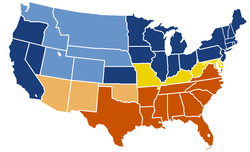
United States map, 1863
Union states
Union territories not permitting slavery
Border Union states, permitting slavery
Confederate states
Union territories permitting slavery (claimed by Confederacy)
The central issue after 1848 was the expansion of slavery, pitting the anti-slavery elements in the North, against the pro-slavery elements that dominated the South. A small number of active Northerners were abolitionists who declared that ownership of slaves was a sin (in terms of Protestant theology) and demanded its immediate abolition. Much larger numbers in the North were against the expansion of slavery, seeking to put it on the path to extinction so that America would be committed to free land (as in low-cost farms owned and cultivated by a family), free labor, and free speech (as opposed to censorship of abolitionist material in the South). Southern whites insisted that slavery was of economic, social, and cultural benefit to all whites (and even to the slaves themselves), and denounced all anti-slavery spokesmen as "abolitionists".[89] Justifications of slavery included economics, history, religion, legality, social good, and even humanitarianism, to further their arguments. Defenders of slavery argued that the sudden end to the slave economy would have had a profound and killing economic impact in the South where reliance on slave labor was the foundation of their economy. They also argued that if all the slaves were freed, there would be widespread unemployment and chaos.[90]
Religious activists split on slavery, with the Methodists and Baptists dividing into northern and southern denominations. In the North, the Methodists, Congregationalists, and Quakers included many abolitionists, especially among women activists. (The Catholic, Episcopal and Lutheran denominations largely ignored the slavery issue.)[91]
Compromise of 1850 and popular sovereignty[edit]
The issue of slavery in the new territories was seemingly settled by the Compromise of 1850, brokered by Whig Henry Clay and Democrat Stephen Douglas; the Compromise included the admission of California as a free state in exchange for no federal restrictions on slavery placed on Utah or New Mexico.[92] The point of contention was the Fugitive Slave Act, which increased federal enforcement and required even free states to cooperate in turning over fugitive slaves to their owners. Abolitionists pounced on the Act to attack slavery, as in the best-selling anti-slavery novel Uncle Tom's Cabin by Harriet Beecher Stowe.[93]
The Compromise of 1820 was repealed in 1854 with the Kansas–Nebraska Act, promoted by Senator Douglas in the name of "popular sovereignty" and democracy. It permitted voters to decide on the legality of slavery in each territory, and allowed Douglas to adopt neutrality on the issue of slavery. Anti-slavery forces rose in anger and alarm, forming the new Republican Party. Pro- and anti- contingents rushed to Kansas to vote slavery up or down, resulting in a miniature civil war called Bleeding Kansas. By the late 1850s, the young Republican Party dominated nearly all northern states and thus the electoral college. It insisted that slavery would never be allowed to expand (and thus would slowly die out).[94]
The plantation economy[edit]
The Southern slavery-based societies had become wealthy based on their cotton and other agricultural commodity production, and some particularly profited from the internal slave trade. Northern cities such as Boston and New York, and regional industries, were tied economically to slavery by banking, shipping, and manufacturing, including textile mills. By 1860, there were four million slaves in the South, nearly eight times as many as there were nationwide in 1790. The plantations were highly profitable, due to the heavy European demand for raw cotton. Most of the profits were invested in new lands and in purchasing more slaves (largely drawn from the declining tobacco regions).

The United States, immediately before the Civil War. All of the lands east of, or bordering, the Mississippi River were organized as states in the Union, but the West was still largely unsettled.
For 50 of the nation's first 72 years, a slaveholder served as President of the United States and, during that period, only slaveholding presidents were re-elected to second terms.[95] In addition, southern states benefited by their increased apportionment in Congress due to the partial counting of slaves in their populations.
Slave rebellions[edit]
Slave rebellions, by Gabriel Prosser (1800), Denmark Vesey (1822), Nat Turner (1831), and most famously by John Brown (1859), caused fear in the white South, which imposed stricter oversight of slaves and reduced the rights of free blacks. The Fugitive Slave Act of 1850 required the states to cooperate with slave owners when attempting to recover escaped slaves, which outraged Northerners. Formerly, an escaped slave that reached a non-slave state was presumed to have attained sanctuary and freedom under the Missouri Compromise. The Supreme Court's 1857 decision in Dred Scott v. Sandford ruled that the Missouri Compromise was unconstitutional; angry Republicans said this decision threatened to make slavery a national institution.
Lincoln and secession[edit]
After Abraham Lincoln won the 1860 election, seven Southern states seceded from the union and set up a new nation, the Confederate States of America (Confederacy), on February 8, 1861. It attacked Fort Sumter, a U.S. Army fort in South Carolina, thus igniting the war. When Lincoln called for troops to suppress the Confederacy in April 1861, four more states seceded and joined the Confederacy. A few of the (northernmost) "slave states" did not secede and became known as the border states; these were Delaware, Maryland, Kentucky, and Missouri.
During the war, the northwestern portion of Virginia seceded from the Confederacy. and became the new Union state of West Virginia.[96] West Virginia is usually associated with the border states.
Civil War[edit]
The Civil War began on April 12, 1861, when elements of 100,000 Confederate forces attacked a U.S. military installation at Fort Sumter in South Carolina. In response to the attack, on April 15, Lincoln called on the states to send detachments totaling 75,000 troops to recapture forts, protect the capital, and "preserve the Union", which in his view still existed intact despite the actions of the seceding states. The two armies had their first major clash at the First Battle of Bull Run (Battle of Manassas), ending in a Union defeat, but, more importantly, proved to both the Union and Confederacy that the war would be much longer and bloodier than originally anticipated.[97]
The war soon divided into two theaters: Eastern and Western. In the western theater, the Union was relatively successful, with major battles, such as Perryville and Shiloh along with Union gunboat dominance of navigable rivers producing strategic Union victories and destroying major Confederate operations.[98]
Warfare in the Eastern theater began poorly for the Union as the Confederates won at Manassas Junction (Bull Run), just outside Washington. Major General George B. McClellan was put in charge of the Union armies. After reorganizing the new Army of the Potomac, McClellan failed to capture the Confederate capital of Richmond, Virginia in his Peninsula Campaign and retreated after attacks from newly appointed Confederate General Robert E. Lee.[99] Meanwhile, both sides concentrated in 1861–62 on raising and training new armies. The main action was Union success in controlling the border states, with Confederates largely driven out of Maryland, West Virginia (a new state), Kentucky and Missouri. The autumn 1862 Confederate campaign into Maryland was designed to hurt Union morale and win European support. It ended with Confederate retreat at the Battle of Antietam, and Lincoln's warning he would issue an Emancipation Proclamation in January 1863 if the states did not return. Making slavery a central war goal Energized Republicans in the North, as well as their enemies, the anti-war Copperhead Democrats. It ended the risk of British and French intervention.
Lee's smaller army won at the Battle of Fredericksburg late in 1862, causing yet another change in commanders. Lee won again at the Battle of Chancellorsville in May 1863, while losing his top aide, Stonewall Jackson. But Lee pushed too hard and ignored the Union threat in the west. Lee invaded Pennsylvania in search of supplies and to cause war-weariness in the North. In perhaps the turning point of the war, Lee's army was badly beaten at the Battle of Gettysburg, July 1–3, 1863, and barely made it back to Virginia.[100] On the homefront, industrial expansion in the North expanded dramatically, using its extensive railroad service, and moving industrial workers into munitions factories. Foreign trade increased, with the United States providing both food and cotton to Britain, And Britain sending in manufactured products and thousands of volunteers for the Union Army (plus a few to the Confederates). The British operated blockade runners bringing in food, luxury items and munitions to the Confederacy, bringing out tobacco and cotton. The Union blockade increasingly shut down Confederate ports, and by late 1864 the blockade runners were usually captured before they could make more than a handful of runs.
In the West, on July 4, 1863, Union forces under the command of General Ulysses S. Grant gained control of the Mississippi River at the Battle of Vicksburg, thereby splitting the Confederacy. Lincoln made General Grant commander of all Union armies. Grant put General William Tecumseh Sherman in charge of the Western armies. In 1864, Sherman marched south from Chattanooga to capture Atlanta, a decisive victory that ended war jitters among Republicans in the North who feared they might fail to reelect Lincoln in 1864. Lincoln won a landslide. The last two years of the war were bloody for both sides, With Sherman marching almost unopposed through central and eastern Georgia, then moving up through South Carolina and North Carolina, burning cities, destroying plantations, ruining railroads and bridges, but avoiding civilian casualties. Sherman demonstrated that the South lacked the long-term ability to resist a northern invasion. Much of the heartland of the Confederacy was physically destroyed, and could no longer provide desperately needed food, horses, mules, wagons, boots or munitions to its combat armies. In spring 1864 Grant, realizing that Lee was unable to replenish casualties, while Lincoln would provide replacements for Union losses, launched a war of attrition against Lee's Army of Northern Virginia. This war of attrition was divided into three main campaigns. The first of these, the Overland Campaign forced Lee to retreat into the city of Petersburg where Grant launched his second major offensive, the Richmond-Petersburg Campaign in which he besieged Petersburg. After a near ten-month siege, Petersburg surrendered. However, the defense of Fort Gregg allowed Lee to move his army out of Petersburg. Grant pursued and launched the final, Appomattox Campaign which resulted in Lee surrendering his Army of Northern Virginia numbering 28,000 on April 9, 1865, at Appomattox Court House. Other Confederate armies followed suit and the war ended with no postwar insurgency.
The American Civil War was the world's earliest industrial war. Railroads, the telegraph, steamships, and mass-produced weapons were employed extensively. The mobilization of civilian factories, mines, shipyards, banks, transportation and food supplies all foreshadowed the impact of industrialization in World War I. It remains the deadliest war in American history, resulting in the deaths of about 750,000 soldiers and an undetermined number of civilian casualties.[101] About ten percent of all Northern males 20–45 years old, and 30 percent of all Southern white males aged 18–40 died.[102] Its legacy includes ending slavery in the United States, restoring the Union, and strengthening the role of the federal government.
According to historian Allan Nevins the Civil War had a major long-term impact on the United States in terms of developing its leadership potential and moving the entire nation beyond the adolescent stage:
- The fighting and its attendant demands upon industry, finance, medicine, and law also helped train a host of leaders who during the next 35 years, to 1900, made their influence powerfully felt on most of the social, economic, and cultural fronts. It broke down barriers of parochialism; it ended distrust of large-scale effort; it hardened and matured the whole people emotionally. The adolescent land of the 1850s…rose under the blows of battle to adult estate. The nation of the post-Appomattox generation, though sadly hurt (especially in the South) by war losses, and deeply scarred psychologically (especially in the North) by war hatreds and greeds, had at last the power, resolution, and self-trust of manhood.[103]
Emancipation[edit]
The Emancipation Proclamation was an executive order issued by President Abraham Lincoln on January 1, 1863. In a single stroke it changed the legal status, as recognized by the U.S. government, of 3 million slaves in designated areas of the Confederacy from "slave" to "free". It had the practical effect that as soon as a slave escaped the control of the Confederate government, by running away or through advances of federal troops, the slave became legally and actually free. The owners were never compensated. Plantation owners, realizing that emancipation would destroy their economic system, sometimes moved their slaves as far as possible out of reach of the Union army. By June 1865, the Union Army controlled all of the Confederacy and liberated all of the designated slaves.[105] Large numbers moved into camps run by the Freedmen's Bureau, where they were given food, shelter, medical care, and arrangements for their employment were made.
The severe dislocations of war and Reconstruction had a large negative impact on the black population, with a large amount of sickness and death.[106]
Reconstruction Era[edit]
Reconstruction lasted from Lincoln's Emancipation Proclamation of January 1, 1863 to the Compromise of 1877.[107]
The major issues faced by Lincoln were the status of the ex-slaves (called "Freedmen"), the loyalty and civil rights of ex-rebels, the status of the 11 ex-Confederate states, the powers of the federal government needed to prevent a future civil war, and the question of whether Congress or the President would make the major decisions.
The severe threats of starvation and displacement of the unemployed Freedmen were met by the first major federal relief agency, the Freedmen's Bureau, operated by the Army.[108]
Three "Reconstruction Amendments" were passed to expand civil rights for black Americans: the Thirteenth Amendment outlawed slavery; the Fourteenth Amendment guaranteed equal rights for all and citizenship for blacks; the Fifteenth Amendment prevented race from being used to disenfranchise men.
Radical Reconstruction[edit]
Ex-Confederates remained in control of most Southern states for over two years, but changed when the Radical Republicans gained control of Congress in the 1866 elections. President Andrew Johnson, who sought easy terms for reunions with ex-rebels, was virtually powerless in the face of the Radical Republican Congress; he was impeached, but the Senate's attempt to remove him from office failed by one vote. Congress enfranchised black men and temporarily stripped many ex-Confederate leaders of the right to hold office. New Republican governments came to power based on a coalition of Freedmen made up of Carpetbaggers (new arrivals from the North), and Scalawags (native white Southerners). They were backed by the U.S. Army. Opponents said they were corrupt and violated the rights of whites.[109]
The KKK and the rise of Jim Crow[edit]

Atlanta's railyard and roundhouse in ruins shortly after the end of the Civil War
State by state they lost power to a conservative-Democratic coalition, which gained control of the entire South by 1877. In response to Radical Reconstruction, the Ku Klux Klan (KKK) emerged in 1867 as a white-supremacist organization opposed to black civil rights and Republican rule. President Ulysses Grant's vigorous enforcement of the Ku Klux Klan Act of 1870 shut down the Klan, and it disbanded. Paramilitary groups, such as the White League and Red Shirts emerged about 1874 that worked openly to use intimidation and violence to suppress black voting to regain white political power in states across the South during the 1870s. Rable described them as the military arm of the Democratic Party.[109]
Reconstruction ended after the disputed 1876 election. The Compromise of 1877 gave Republican candidate Rutherford B. Hayes the White House in exchange for removing all remaining federal troops in the South. The federal government withdrew its troops from the South, and Southern Democrats took control of every Southern state.[110] From 1890 to 1908, southern states effectively disfranchised most black voters and many poor whites by making voter registration more difficult through poll taxes, literacy tests, and other arbitrary devices. They passed segregation laws and imposed second-class status on blacks in a system known as Jim Crow that lasted until the Civil Rights Movement.[111][112]
Growth and industrialization[edit]
The frontier and the railroad[edit]
The latter half of the nineteenth century was marked by the rapid development and settlement of the far West, first by wagon trains and riverboats and then aided by the completion of the transcontinental railroad. Large numbers of European immigrants (especially from Germany and Scandinavia) took up low-cost or free farms in the Prairie States. Mining for silver and copper opened up the Mountain West.
Indian wars[edit]
The United States Army fought frequent small-scale wars with Native Americans as settlers encroached on their traditional lands. Gradually the U.S. purchased the Native American tribal lands and extinguished their claims, forcing most tribes onto subsidized reservations. According to the U.S. Bureau of the Census (1894), from 1789 to 1894:
The Indian wars under the government of the United States have been more than 40 in number. They have cost the lives of about 19,000 white men, women and children, including those killed in individual combats, and the lives of about 30,000 Indians. The actual number of killed and wounded Indians must be very much higher than the given... Fifty percent additional would be a safe estimate.[113]
The Gilded Age[edit]
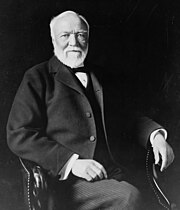
Scottish immigrant
Andrew Carnegie led the enormous expansion of the American steel industry.
The "Gilded Age" was a term that Mark Twain used to describe the period of the late 19th century with a dramatic expansion of American wealth and prosperity, underscored by the mass corruption in the government. Reforms of the Age included the Civil Service Act, which mandated a competitive examination for applicants for government jobs. Other important legislation included the Interstate Commerce Act, which ended railroads' discrimination against small shippers, and the Sherman Antitrust Act, which outlawed monopolies in business. Twain believed that this age was corrupted by such elements as land speculators, scandalous politics, and unethical business practices.[114] Since the days of Charles A. Beard and Matthew Josephson, some historians have argued that the United States was effectively plutocratic for at least part of the Gilded Age and Progressive Era.[115][116][117][118][119] As financiers and industrialists such as J.P. Morgan and John D. Rockefeller began to amass vast fortunes, many U.S. observers were concerned that the nation was losing its pioneering egalitarian spirit.[120]
By 1890 American industrial production and per capita income exceeded those of all other world nations. In response to heavy debts and decreasing farm prices, wheat and cotton farmers joined the Populist Party.[121] An unprecedented wave of immigration from Europe served to both provide the labor for American industry and create diverse communities in previously undeveloped areas. From 1880 to 1914, peak years of immigration, more than 22 million people migrated to the United States.[122] Most were unskilled workers who quickly found jobs in mines, mills, and factories. Many immigrants were craftsmen (especially from Britain and Germany) bringing human skills, and others were farmers (especially from Germany and Scandinavia) who purchased inexpensive land on the Prairies from railroads who sent agents to Europe. Poverty, growing inequality and dangerous working conditions, along with socialist and anarchist ideas diffusing from European immigrants, led to the rise of the labor movement, which often included violent strikes.[123][124]
Unions and strikes[edit]
Skilled workers banded together to control their crafts and raise wages by forming labor unions in industrial areas of the Northeast. Before the 1930s few factory workers joined the unions in the labor movement. Samuel Gompers led the American Federation of Labor (1886–1924), coordinating multiple unions. Industrial growth was rapid, led by John D. Rockefeller in oil and Andrew Carnegie in steel; both became leaders of philanthropy (Gospel of Wealth), giving away their fortunes to create the modern system of hospitals, universities, libraries, and foundations.

Mulberry Street, along which Manhattan's
Little Italy is centered.
Lower East Side, circa 1900. Almost 97% of residents of the 10 largest American cities of 1900 were non-Hispanic whites.
[125]The Panic of 1893 broke out and was a severe nationwide depression impacting farmers, workers, and businessmen who saw prices, wages, and profits fall.[126] Many railroads went bankrupt. The resultant political reaction fell on the Democratic Party, whose leader President Grover Cleveland shouldered much of the blame. Labor unrest involved numerous strikes, most notably the violent Pullman Strike of 1894, which was shut down by federal troops under Cleveland's orders. The Populist Party gained strength among cotton and wheat farmers, as well as coal miners, but was overtaken by the even more popular Free Silver movement, which demanded using silver to enlarge the money supply, leading to inflation that the silverites promised would end the depression.[127]
The financial, railroad, and business communities fought back hard, arguing that only the gold standard would save the economy. In the most intense election in the nation's history, conservative Republican William McKinley defeated silverite William Jennings Bryan, who ran on the Democratic, Populist, and Silver Republican tickets. Bryan swept the South and West, but McKinley ran up landslides among the middle class, industrial workers, cities, and among upscale farmers in the Midwest.[128]
Prosperity returned under McKinley, the gold standard was enacted, and the tariff was raised. By 1900 the U.S. had the strongest economy on the globe. Apart from two short recessions (in 1907 and 1920) the overall economy remained prosperous and growing until 1929. Republicans, citing McKinley's policies, took the credit.[129]
Imperialism[edit]

This cartoon reflects the view of
Judge magazine regarding America's imperial ambitions following a quick victory in the Spanish–American War of 1898.
[130] The American flag flies from the Philippines and Hawaii in the Pacific to Cuba and Puerto Rico in the Caribbean.
The United States emerged as a world economic and military power after 1890. The main episode was the Spanish–American War, which began when Spain refused American demands to reform its oppressive policies in Cuba.[131] The "splendid little war", as one official called it, involved a series of quick American victories on land and at sea. At the Treaty of Paris peace conference the United States acquired the Philippines, Puerto Rico, and Guam.[132]
Cuba became an independent country, under close American tutelage. Although the war itself was widely popular, the peace terms proved controversial. William Jennings Bryan led his Democratic Party in opposition to control of the Philippines, which he denounced as imperialism unbecoming to American democracy.[132] President William McKinley defended the acquisition and was riding high as the nation had returned to prosperity and felt triumphant in the war. McKinley easily defeated Bryan in a rematch in the 1900 presidential election.[133]
After defeating an insurrection by Filipino nationalists, the United States engaged in a large-scale program to modernize the economy of the Philippines and dramatically upgrade the public health facilities.[134] By 1908, however, Americans lost interest in an empire and turned their international attention to the Caribbean, especially the building of the Panama Canal. In 1912 when Arizona became the final mainland state, the American Frontier came to an end. The canal opened in 1914 and increased trade with Japan and the rest of the Far East. A key innovation was the Open Door Policy, whereby the imperial powers were given equal access to Chinese business, with not one of them allowed to take control of China.[135]
Discontent and reform[edit]
Progressive Era[edit]

American children of many ethnic backgrounds celebrate noisily in a 1902
Puck cartoon.
Dissatisfaction on the part of the growing middle class with the corruption and inefficiency of politics as usual, and the failure to deal with increasingly important urban and industrial problems, led to the dynamic Progressive Movement starting in the 1890s. In every major city and state, and at the national level as well, and in education, medicine, and industry, the progressives called for the modernization and reform of decrepit institutions, the elimination of corruption in politics, and the introduction of efficiency as a criterion for change. Leading politicians from both parties, most notably Theodore Roosevelt, Charles Evans Hughes, and Robert La Follette on the Republican side, and William Jennings Bryan and Woodrow Wilson on the Democratic side, took up the cause of progressive reform. Women became especially involved in demands for woman suffrage, prohibition, and better schools; their most prominent leader was Jane Addams of Chicago, who created settlement houses. "Muckraking" journalists such as Upton Sinclair, Lincoln Steffens and Jacob Riis exposed corruption in business and government along with rampant inner-city poverty. Progressives implemented antitrust laws and regulated such industries of meat-packing, drugs, and railroads. Four new constitutional amendments – the Sixteenth through Nineteenth – resulted from progressive activism, bringing the federal income tax, direct election of Senators, prohibition, and woman suffrage.[136] The period also saw a major transformation of the banking system with the creation of the Federal Reserve System in 1913[137] and the arrival of cooperative banking in the US with the founding of the first credit union in 1908.[138] The Progressive Movement lasted through the 1920s; the most active period was 1900–18.[139]
Women's suffrage[edit]
The women's suffrage movement began with the June 1848 National Convention of the Liberty Party. Presidential candidate Gerrit Smith argued for and established women's suffrage as a party plank. One month later, his cousin Elizabeth Cady Stanton joined with Lucretia Mott and other women to organize the Seneca Falls Convention, featuring the Declaration of Sentiments demanding equal rights for women, and the right to vote.[140] Many of these activists became politically aware during the abolitionist movement. The women's rights campaign during "first-wave feminism" was led by Stanton, Lucy Stone and Susan B. Anthony, among many others. Stone and Paulina Wright Davis organized the prominent and influential National Women's Rights Convention in 1850. The movement reorganized after the Civil War, gaining experienced campaigners, many of whom had worked for prohibition in the Women's Christian Temperance Union. By the end of the 19th century a few western states had granted women full voting rights,[141] though women had made significant legal victories, gaining rights in areas such as property and child custody.[142]
Around 1912 the feminist movement began to reawaken, putting an emphasis on its demands for equality and arguing that the corruption of American politics demanded purification by women because men could not do that job.[143] Protests became increasingly common as suffragette Alice Paul led parades through the capital and major cities. Paul split from the large National American Woman Suffrage Association (NAWSA), which favored a more moderate approach and supported the Democratic Party and Woodrow Wilson, led by Carrie Chapman Catt, and formed the more militant National Woman's Party. Suffragists were arrested during their "Silent Sentinels" pickets at the White House, the first time such a tactic was used, and were taken as political prisoners.[144]
The old anti-suffragist argument that only men could fight a war, and therefore only men deserve the right to vote, was refuted by the enthusiastic participation of tens of thousands of American women on the home front in World War I. Across the world, grateful nations gave women the right to vote. Furthermore, most of the Western states had already given the women the right to vote in state and national elections, and the representatives from those states, including the first woman Jeannette Rankin of Montana, demonstrated that woman suffrage was a success. The main resistance came from the south, where white leaders were worried about the threat of black women voting. Congress passed the Nineteenth Amendment in 1919, and women could vote in 1920.[145]
NAWSA became the League of Women Voters, and the National Woman's Party began lobbying for full equality and the Equal Rights Amendment, which would pass Congress during the second wave of the women's movement in 1972. Politicians responded to the new electorate by emphasizing issues of special interest to women, especially prohibition, child health, and world peace.[146][147] The main surge of women voting came in 1928, when the big-city machines realized they needed the support of women to elect Al Smith, a Catholic from New York City. Meanwhile, Protestants mobilized women to support Prohibition and vote for Republican Herbert Hoover.[148]
Women suffragists demonstrating for the right to vote in 1913.
Women's suffragists parade in New York City in 1917, carrying placards with signatures of more than a million women.[149]
War, prosperity, and depression[edit]
World War I[edit]
As World War I raged in Europe from 1914, President Woodrow Wilson took full control of foreign policy, declaring neutrality but warning Germany that resumption of unrestricted submarine warfare against American ships supplying goods to Allied nations would mean war. Germany decided to take the risk and try to win by cutting off supplies to Britain through the sinking of ships such as the RMS Lusitania; the U.S. declared war in April 1917 mainly from the threat of the Zimmermann Telegram.[150] American money, food, and munitions arrived quickly, but troops had to be drafted and trained; by summer 1918 American soldiers under General John J. Pershing's American Expeditionary Forces arrived at the rate of 10,000 a day, while Germany was unable to replace its losses.[151] Dissent against the war was suppressed by the Sedition Act of 1918 & Espionage Act of 1917, German language, leftist & pacifist publications were suppressed, and over 2,000 were imprisoned for speaking out against the war, the political prisoners were later released by U.S President Warren G. Harding.[152]
The result was Allied victory in November 1918. President Wilson demanded Germany depose the Kaiser and accept his terms in the famed Fourteen Points speech. Wilson dominated the 1919 Paris Peace Conference but Germany was treated harshly by the Allies in the Treaty of Versailles (1919) as Wilson put all his hopes in the new League of Nations. Wilson refused to compromise with Senate Republicans over the issue of Congressional power to declare war, and the Senate rejected the Treaty and the League.[153]
Roaring Twenties[edit]

Prohibition agents destroying barrels of alcohol in Chicago, 1921.
In the 1920s the U.S. grew steadily in stature as an economic and military world power. The United States Senate did not ratify the Treaty of Versailles imposed by its Allies on the defeated Central Powers; instead, the United States chose to pursue unilateralism.[154] The aftershock of Russia's October Revolution resulted in real fears of Communism in the United States, leading to a Red Scare and the deportation of aliens considered subversive.
While public health facilities grew rapidly in the Progressive Era, and hospitals and medical schools were modernized,[155] the nation in 1918 lost 675,000 lives to the Spanish flu pandemic.[156]
In 1920, the manufacture, sale, import and export of alcohol were prohibited by the Eighteenth Amendment, Prohibition. The result was that in cities illegal alcohol became a big business, largely controlled by racketeers. The second Ku Klux Klan grew rapidly in 1922–25, then collapsed. Immigration laws were passed to strictly limit the number of new entries. The 1920s were called the Roaring Twenties due to the great economic prosperity during this period. Jazz became popular among the younger generation, and thus the decade was also called the Jazz Age.
The Great Depression (1929–1939) and the New Deal (1933–1936) were decisive moments in American political, economic, and social history that reshaped the nation.[157]
Great Depression and the New Deal[edit]
During the 1920s, the nation enjoyed widespread prosperity, albeit with a weakness in agriculture. A financial bubble was fueled by an inflated stock market, which later led to the Stock Market Crash on October 29, 1929.[158] This, along with many other economic factors, triggered a worldwide depression known as the Great Depression. During this time, the United States experienced deflation as prices fell, unemployment soared from 3% in 1929 to 25% in 1933, farm prices fell by half, and manufacturing output plunged by one-third.
President
Franklin Roosevelt engaged in radio
Fireside chats as means with regularly communicating with the public, this was innovative for the time. During the first visit of a sitting U.S. president to Brazil, 1936.
In 1932, Democratic presidential nominee Franklin D. Roosevelt promised "a New Deal for the American people", coining the enduring label for his domestic policies. The result was a series of permanent reform programs including Relief for the unemployed, assistance for the elderly, jobs for young men, social security, unemployment insurance, public housing, bankruptcy insurance, farm subsidies, and regulation of financial securities. State governments added new programs as well, and introduced the sales tax to pay for them. Ideologically the revolution established modern liberalism in the United States and kept the Democrats in power in Washington almost continuously for Three decades thanks to the New Deal Coalition of ethnic Whites, Blacks, blue-collar workers, labor unions, and white Southerners. It provided relief to the long-term unemployed through numerous programs, such as the Works Progress Administration (WPA) and for young men, the Civilian Conservation Corps. Large scale spending projects designed to provide private sector construction jobs and rebuild the infrastructure were under the purview of the Public Works Administration. The Second New Deal was a turn to the left in 1935–36, building up labor unions through the Wagner Act. Unions became a powerful element of the merging New Deal Coalition, which won reelection for Roosevelt in 1936, 1940, and 1944 by mobilizing union members, blue collar workers, relief recipients, big city machines, ethnic, and religious groups (especially Catholics and Jews) and the white South, along with blacks in the North (where they could vote). Roosevelt seriously weakened his second term by a failed effort to pack the Supreme Court, which had been a center of conservative resistance to his programs. Most of the relief programs were dropped after 1938 in the 1940s when the conservatives regained power in Congress through the Conservative Coalition. Of special importance is the Social Security program, begun in 1935. The economy basically recovered by 1936, but had a sharp, short recession in 1937–38; long-term unemployment, however, remained a problem until it was solved by wartime spending.[159]
In an effort to denounce past U.S. interventionism and subdue any subsequent fears of Latin Americans, Roosevelt announced on March 4, 1933, during his inaugural address, "In the field of World policy, I would dedicate this nation to the policy of the good neighbor, the neighbor who resolutely respects himself and, because he does so, respects the rights of others, the neighbor who respects his obligations and respects the sanctity of his agreements in and with a World of neighbors."[160] To create a friendly relationship between the United States and Central as well as South American countries, Roosevelt sought to stray from asserting military force in the region.[161] This position was affirmed by Cordell Hull, Roosevelt's Secretary of State at a conference of American states in Montevideo in December 1933.
World War II[edit]
American corpses sprawled on the beach of Tarawa, November 1943.
In the Depression years, the United States remained focused on domestic concerns while democracy declined across the world and many countries fell under the control of dictators. Imperial Japan asserted dominance in East Asia and in the Pacific. Nazi Germany and Fascist Italy militarized and threatened conquests, while Britain and France attempted appeasement to avert another war in Europe. U.S. legislation in the Neutrality Acts sought to avoid foreign conflicts; however, policy clashed with increasing anti-Nazi feelings following the German invasion of Poland in September 1939 that started World War II. Roosevelt positioned the U.S. as the "Arsenal of Democracy", pledging full-scale financial and munitions support for the Allies – but no military personnel.[162] This was carried out through the Lend-Lease agreements. Japan tried to neutralize America's power in the Pacific by attacking Pearl Harbor on December 7, 1941, which catalyzed American support to enter the war.[163]
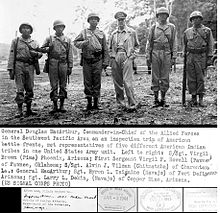
General
Douglas MacArthur meeting
Navajo,
Pima,
Pawnee and other Native American troops. Navajo served as
code talkers for the military in the Pacific. The code they made, although cryptologically very simple, was never cracked by the Japanese.
The main contributions of the U.S. to the Allied war effort comprised money, industrial output, food, petroleum, technological innovation, and (especially 1944–45), military personnel. Much of the focus in Washington was maximizing the economic output of the nation. The overall result was a dramatic increase in GDP, the export of vast quantities of supplies to the Allies and to American forces overseas, the end of unemployment, and a rise in civilian consumption even as 40% of the GDP went to the war effort. This was achieved by tens of millions of workers moving from low-productivity occupations to high-efficiency jobs, improvements in productivity through better technology and management, and the move into the active labor force of students, retired people, housewives, and the unemployed, and an increase in hours worked.
It was exhausting; leisure activities declined sharply. People tolerated the extra work because of patriotism, the pay, and the confidence that it was only "for the duration", and life would return to normal as soon as the war was won. Most durable goods became unavailable, and meat, clothing, and gasoline were tightly rationed. In industrial areas housing was in short supply as people doubled up and lived in cramped quarters. Prices and wages were controlled, and Americans saved a high portion of their incomes, which led to renewed growth after the war instead of a return to depression.[164][165]
The Allies – the United States, Britain, and the Soviet Union, China, as well as Poland, Canada, and other countries – fought the Axis powers of Germany, Italy, and Japan. The Allies saw Germany as the main threat and gave the highest priority to Europe. The U.S. dominated the war against Japan and stopped Japanese expansion in the Pacific in 1942. After losing Pearl Harbor and in the Philippines to the Japanese, and drawing the Battle of the Coral Sea (May 1942), the American Navy inflicted a decisive blow at Midway (June 1942). American ground forces assisted in the North African Campaign that eventually concluded with the collapse of Mussolini's fascist government in 1943, as Italy switched to the Allied side. A more significant European front was opened on D-Day, June 6, 1944, in which American and Allied forces invaded Nazi-occupied France from Britain.
On the home front, mobilization of the U.S. economy was managed by Roosevelt's War Production Board. The wartime production boom led to full employment, wiping out this vestige of the Great Depression. Indeed, labor shortages encouraged industry to look for new sources of workers, finding new roles for women and blacks.[166]
However, the fervor also inspired anti-Japanese sentiment, leading to internment of Japanese Americans.[167] This was taken under the directive of President Roosevelt, who signed Executive Order 9066. The terms of this executive order resulted in some 120,000 people of Japanese descent living in the US removed from their homes and placed in internment camps. Two-thirds of those interned were American citizens and half of them were children. Those who were as little as 1/16 Japanese[168] and orphaned infants with "one drop of Japanese blood" were placed in internment camps.[169] The US Supreme Court held the Japanese American internment camps to be constitutional in a 6–3 decision in Korematsu v. United States Supreme Court case.[170]
Research and development took flight as well, best seen in the Manhattan Project, a secret effort to harness nuclear fission to produce highly destructive atomic bombs.[171] From 1942 to 1946, the project was under the direction of Major General Leslie Groves of the U.S. Army Corps of Engineers. Nuclear physicist J. Robert Oppenheimer was the director of the Los Alamos Laboratory that designed the actual bombs. The first nuclear device ever detonated was an implosion-type bomb at the Trinity test, conducted at New Mexico's Alamogordo Bombing and Gunnery Range on July 16, 1945.[172]
The Allies pushed the Germans out of France but faced an unexpected counterattack at the Battle of the Bulge in December. The final German effort failed, and, as Allied armies in East and West were converging on Berlin, the Nazis hurriedly tried to kill the last remaining Jews. The western front stopped short, leaving Berlin to the Soviets as the Nazi regime formally capitulated in May 1945, ending the war in Europe.[173] Over in the Pacific, the U.S. implemented an island hopping strategy toward Tokyo, establishing airfields for bombing runs against mainland Japan from the Mariana Islands and achieving hard-fought victories at Iwo Jima and Okinawa in 1945.[174] Bloodied at Okinawa, the U.S. prepared to invade Japan's home islands when B-29s dropped atomic bombs on the Japanese cities of Hiroshima and Nagasaki, forcing the empire's surrender in a matter of days and thus ending World War II.[175] The U.S. occupied Japan (and part of Germany), sending Douglas MacArthur to restructure the Japanese economy and political system along American lines.[176] During the war, Roosevelt coined the term "Four Powers" to refer four major Allies of World War II, the United States, the United Kingdom, the Soviet Union, and China, which later became the foundation of the United Nations Security Council.[177]
Though the nation lost more than 400,000 military personnel,[178] the mainland prospered untouched by the devastation of war that inflicted a heavy toll on Europe and Asia.
Participation in postwar foreign affairs marked the end of predominant American isolationism. The awesome threat of nuclear weapons inspired both optimism and fear. Nuclear weapons were never used after 1945, as both sides drew back from the brink and a "long peace" characterized the Cold War years, starting with the Truman Doctrine on May 22, 1947. There were, however, regional wars in Korea and Vietnam.[179]
Postwar America[edit]
The Cold War[edit]

Cuban Missile Crisis a U-2 reconnaissance photograph of Cuba, showing Soviet nuclear missiles, their transports and tents for fueling and maintenance.
Following World War II, the United States emerged as one of the two dominant superpowers, the USSR being the other. The U.S. Senate on a bipartisan vote approved U.S. participation in the United Nations (UN), which marked a turn away from the traditional isolationism of the U.S. and toward increased international involvement.
The primary American goal of 1945–1948 was to rescue Europe from the devastation of World War II and to contain the expansion of Communism, represented by the Soviet Union. U.S. foreign policy during the Cold War was built around the support of Western Europe and Japan along with the policy of containment, stopping the spread of communism. The U.S. joined the wars in Korea and Vietnam and toppled left-wing governments in the third world to try to stop its spread.[180] The Truman Doctrine of 1947 provided military and economic aid to Greece and Turkey to counteract the threat of Communist expansion in the Balkans. In 1948, the United States replaced piecemeal financial aid programs with a comprehensive Marshall Plan, which pumped money into the economy of Western Europe, and removed trade barriers, while modernizing the managerial practices of businesses and governments.[181]
The Plan's $13 billion budget was in the context of a U.S. GDP of $258 billion in 1948 and was in addition to the $12 billion in American aid given to Europe between the end of the war and the start of the Marshall Plan. Soviet head of state Joseph Stalin prevented his satellite states from participating, and from that point on, Eastern Europe, with inefficient centralized economies, fell further and further behind Western Europe in terms of economic development and prosperity. In 1949, the United States, rejecting the long-standing policy of no military alliances in peacetime, formed the North Atlantic Treaty Organization (NATO) alliance, which continues into the 21st century. In response the Soviets formed the Warsaw Pact of communist states, leading to the "Iron Curtain".[181] In August 1949 the Soviets tested their first nuclear weapon, thereby escalating the risk of warfare. The threat of mutually assured destruction however, prevented both powers from nuclear war, and resulted in proxy wars, especially in Korea and Vietnam, in which the two sides did not directly confront each other.[179]
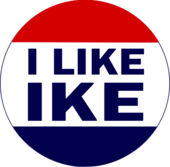
Eisenhower button from the 1952 campaign
President Dwight D Eisenhower, elected in a landslide as the first Republican president since 1932, had a lasting impact on American life and politics.[182] He ended the Korean War, and avoided any other major conflict. He cut military spending by reliance on very high technology, such as nuclear weapons carried by long-range bombers and intercontinental missiles. He gave strong support to the NATO alliance, and built other alliances along similar lines, but they never were especially effective. After Stalin died in 1953 he worked to obtain friendlier relationships with the Soviet Union. At home he ended McCarthyism, expanded the Social Security program and presided over a decade of bipartisan comity. He promoted civil rights cautiously, and sent in the Army when trouble threatened over racial integration in Little Rock Arkansas.[183] The unexpected leapfrogging of American technology by the Soviets in 1957 with Sputnik, the first Earth satellite, began the Space Race, won in 1969 by the Americans as Apollo 11 landed astronauts on the Moon. The angst about the weaknesses of American education led to large-scale federal support for science education and research.[184] In the decades after World War II, the United States became a global influence in economic, political, military, cultural, and technological affairs.
In 1960, the charismatic John F. Kennedy was elected as the first and – thus far – only Roman Catholic President. The Kennedy clan brought a new life and vigor to the atmosphere of the White House. His time in office was marked by such notable events as the acceleration of the United States' role in the Space Race, escalation of the American role in the Vietnam War, the Bay of Pigs Invasion, the Cuban Missile Crisis, the jailing of Martin Luther King, Jr. during the Birmingham campaign. Kennedy was assassinated on November 22, 1963, leaving the nation in profound shock.[185]
Climax of liberalism[edit]

American soldiers during the Vietnam War, 1967
The climax of liberalism came in the mid-1960s with the success of President Lyndon B. Johnson (1963–1969) in securing congressional passage of his Great Society programs.[186] They included civil rights, the end of legal segregation, Medicare, extension of welfare, federal aid to education at all levels, subsidies for the arts and humanities, environmental activism, and a series of programs designed to wipe out poverty.[187][188] As recent historians have explained:
Gradually, liberal intellectuals crafted a new vision for achieving economic and social justice. The liberalism of the early 1960s contained no hint of radicalism, little disposition to revive new deal era crusades against concentrated economic power, and no intention to redistribute wealth or restructure existing institutions. Internationally it was strongly anti-Communist. It aimed to defend the free world, to encourage economic growth at home, and to ensure that the resulting plenty was fairly distributed. Their agenda-much influenced by Keynesian economic theory-envisioned massive public expenditure that would speed economic growth, thus providing the public resources to fund larger welfare, housing, health, and educational programs.[189]
Johnson was rewarded with an electoral landslide in 1964 against conservative Barry Goldwater, which broke the decades-long control of Congress by the Conservative Coalition. However, the Republicans bounced back in 1966 and elected Richard Nixon in 1968. Nixon largely continued the New Deal and Great Society programs he inherited; conservative reaction would come with the election of Ronald Reagan in 1980.[190] Meanwhile, the American people completed a great migration from farms into the cities and experienced a period of sustained economic expansion.
Decades of change[edit]
Counterculture and civil rights[edit]
Civil Rights Movement[edit]

Civil Rights leader Martin Luther King Jr. (right), with President Lyndon B. Johnson in the background (left)
Starting in the late 1950s, institutionalized racism across the United States, but especially in the South, was increasingly challenged by the growing Civil Rights Movement. The activism of African-American leaders Rosa Parks and Martin Luther King, Jr. led to the Montgomery Bus Boycott, which launched the movement. For years African Americans would struggle with violence against them but would achieve great steps toward equality with Supreme Court decisions, including Brown v. Board of Education and Loving v. Virginia, the Civil Rights Act of 1964, the Voting Rights Act of 1965, and the Fair Housing Act of 1968, which ended the Jim Crow laws that legalized racial segregation between whites and blacks.[191]

Duncan West speaking with
Cesar Chavez. The Delano
UFW rally. Duncan represented the
Teamsters who were supporting the UFW and condemning their IBT leadership for working as thugs against a fellow union. Duncan and his wife Mary were the branch organizers of the LA IS.
Martin Luther King, Jr., who had won the Nobel Peace Prize for his efforts to achieve equality of the races, was assassinated in 1968. Following his death others led the movement, most notably King's widow, Coretta Scott King, who was also active, like her husband, in the Opposition to the Vietnam War, and in the Women's Liberation Movement. There were 164 riots in 128 American cities in the first nine months of 1967.[192] Frustrations with the seemingly slow progress of the integration movement led to the emergence of more radical discourses during the early 1960s, which, in turn, gave rise to the Black Power movement of the late 1960s and early 1970s.[193] The decade would ultimately bring about positive strides toward integration, especially in government service, sports, and entertainment. Native Americans turned to the federal courts to fight for their land rights. They held protests highlighting the federal government's failure to honor treaties. One of the most outspoken Native American groups was the American Indian Movement (AIM). In the 1960s, Cesar Chavez began organizing poorly paid Mexican-American farm workers in California. He led a five-year-long strike by grape pickers. Then Chávez formed the nation's first successful union of farm workers. His United Farm Workers of America (UFW) faltered after a few years but after Chavez died in 1993 he became an iconic "folk saint" in the pantheon of Mexican Americans.[194]
The Women's Movement[edit]

Anti-Vietnam War demonstration, 1967
A new consciousness of the inequality of American women began sweeping the nation, starting with the 1963 publication of Betty Friedan's best-seller, The Feminine Mystique, which explained how many housewives felt trapped and unfulfilled, assaulted American culture for its creation of the notion that women could only find fulfillment through their roles as wives, mothers, and keepers of the home, and argued that women were just as able as men to do every type of job. In 1966 Friedan and others established the National Organization for Women, or NOW, to act for women as the NAACP did for African Americans.[142][195]
Protests began, and the new Women's Liberation Movement grew in size and power, gained much media attention, and, by 1968, had replaced the Civil Rights Movement as the U.S's main social revolution. Marches, parades, rallies, boycotts, and pickets brought out thousands, sometimes millions. There were striking gains for women in medicine, law, and business, while only a few were elected to office. The Movement was split into factions by political ideology early on, however (with NOW on the left, the Women's Equity Action League (WEAL) on the right, the National Women's Political Caucus (NWPC) in the center, and more radical groups formed by younger women on the far left). The proposed Equal Rights Amendment to the Constitution, passed by Congress in 1972 was defeated by a conservative coalition mobilized by Phyllis Schlafly. They argued that it degraded the position of the housewife and made young women susceptible to the military draft.[196][197]
However, many federal laws (i.e., those equalizing pay, employment, education, employment opportunities, and credit; ending pregnancy discrimination; and requiring NASA, the Military Academies, and other organizations to admit women), state laws (i.e., those ending spousal abuse and marital rape), Supreme Court rulings (i.e. ruling that the equal protection clause of the Fourteenth Amendment applied to women), and state ERAs established women's equal status under the law, and social custom and consciousness began to change, accepting women's equality. The controversial issue of abortion, deemed by the Supreme Court as a fundamental right in Roe v. Wade (1973), is still a point of debate today.[198]
The Counterculture Revolution and Cold War Détente[edit]
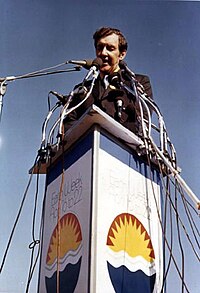
U.S. Senator
Edmund Muskie speaking at Fairmount Park, Philadelphia on Earth Day, 1970
Amid the Cold War, the United States entered the Vietnam War, whose growing unpopularity fed already existing social movements, including those among women, minorities, and young people. President Lyndon B. Johnson's Great Society social programs and numerous rulings by the Warren Court added to the wide range of social reform during the 1960s and 1970s. Feminism and the environmental movement became political forces, and progress continued toward civil rights for all Americans. The Counterculture Revolution swept through the nation and much of the western world in the late sixties and early seventies, further dividing Americans in a "culture war" but also bringing forth more liberated social views.[199]
Johnson was succeeded in 1969 by Republican Richard Nixon, who attempted to gradually turn the war over to the South Vietnamese forces. He negotiated the peace treaty in 1973 which secured the release of POWs and led to the withdrawal of U.S. troops. The war had cost the lives of 58,000 American troops. Nixon manipulated the fierce distrust between the Soviet Union and China to the advantage of the United States, achieving détente (relaxation; ease of tension) with both parties.[200]
The Watergate scandal, involving Nixon's cover-up of his operatives' break-in into the Democratic National Committee headquarters at the Watergate office complex destroyed his political base, sent many aides to prison, and forced Nixon's resignation on August 9, 1974. He was succeeded by Vice President Gerald Ford. The Fall of Saigon ended the Vietnam War and resulted in North and South Vietnam being reunited. Communist victories in neighboring Cambodia and Laos occurred in the same year.[200]
The OPEC oil embargo marked a long-term economic transition since, for the first time, energy prices skyrocketed, and American factories faced serious competition from foreign automobiles, clothing, electronics, and consumer goods. By the late 1970s the economy suffered an energy crisis, slow economic growth, high unemployment, and very high inflation coupled with high interest rates (the term stagflation was coined). Since economists agreed on the wisdom of deregulation, many of the New Deal era regulations were ended, such as in transportation, banking, and telecommunications.[201]
Jimmy Carter, running as someone who was not a part of the Washington political establishment, was elected president in 1976.[202] On the world stage, Carter brokered the Camp David Accords between Israel and Egypt. In 1979, Iranian students stormed the U.S. embassy in Tehran and took 66 Americans hostage, resulting in the Iran hostage crisis. With the hostage crisis and continuing stagflation, Carter lost the 1980 election to the Republican Ronald Reagan.[203] On January 20, 1981, minutes after Carter's term in office ended, the remaining U.S. captives held at the U.S. embassy in Iran were released, ending the 444-day hostage crisis.[204]
Rise of conservatism and the end of the Cold War[edit]
Ronald Reagan produced a major realignment with his 1980 and 1984 landslide elections. Reagan's economic policies (dubbed "Reaganomics") and the implementation of the Economic Recovery Tax Act of 1981 lowered the top marginal tax rate from 70% to 28% over the course of seven years.[205] Reagan continued to downsize government taxation and regulation.[206] The U.S. experienced a recession in 1982, but the negative indicators reversed, with the inflation rate decreasing from 11% to 2%, the unemployment rate decreasing from 10.8% in December 1982 to 7.5% in November 1984,[207] and the economic growth rate increasing from 4.5% to 7.2%.[208]
Reagan ordered a buildup of the U.S. military, incurring additional budget deficits. Reagan introduced a complicated missile defense system known as the Strategic Defense Initiative (SDI) (dubbed "Star Wars" by opponents) in which, theoretically, the U.S. could shoot down missiles with laser systems in space. The Soviets reacted harshly because they thought it violated the 1972 Anti-Ballistic Missile Treaty, and would upset the balance of power by giving the U.S. a major military advantage. For years Soviet leader Mikhail Gorbachev argued vehemently against SDI. However, by the late 1980s he decided the system would never work and should not be used to block disarmament deals with the U.S.[209] Historians argue how great an impact the SDI threat had on the Soviets – whether it was enough to force Gorbachev to initiate radical reforms, or whether the deterioration of the Soviet economy alone forced the reforms. There is agreement that the Soviets realized they were well behind the Americans in military technology, that to try to catch up would be very expensive, and that the military expenses were already a very heavy burden slowing down their economy.[210]
Reagan's Invasion of Grenada and bombing of Libya were popular in the U.S, though his backing of the Contras rebels was mired in the controversy over the Iran–Contra affair that revealed Reagan's poor management style.[211]
Reagan met four times with Soviet leader Mikhail Gorbachev, who ascended to power in 1985, and their summit conferences led to the signing of the Intermediate-Range Nuclear Forces Treaty. Gorbachev tried to save Communism in the Soviet Union first by ending the expensive arms race with America,[213] then by shedding the East European empire in 1989. The Soviet Union collapsed on Christmas Day 1991, ending the U.S–Soviet Cold War.
The United States emerged as the world's sole remaining superpower and continued to intervene in international affairs during the 1990s, including the 1991 Gulf War against Iraq. Following his election in 1992, President Bill Clinton oversaw one of the longest periods of economic expansion and unprecedented gains in securities values, a side effect of the digital revolution and new business opportunities created by the Internet. He also worked with the Republican Congress to pass the first balanced federal budget in 30 years.[214]
In 1998, Clinton was impeached by the House of Representatives on charges of lying about a sexual relationship with White House intern Monica Lewinsky. He was acquitted by the Senate. The failure of impeachment and the Democratic gains in the 1998 election forced House Speaker Newt Gingrich, a Republican, to resign from Congress.[214]
The Republican Party expanded its base throughout the South after 1968 (excepting 1976), largely due to its strength among socially conservative white Evangelical Protestants and traditionalist Roman Catholics, added to its traditional strength in the business community and suburbs. As white Democrats in the South lost dominance of the Democratic Party in the 1990s, the region took on the two-party apparatus which characterized most of the nation. The Republican Party's central leader by 1980 was Ronald Reagan, whose conservative policies called for reduced government spending and regulation, lower taxes, and a strong anti-Soviet foreign policy. His iconic status in the party persists into the 21st century, as practically all Republican Party leaders acknowledge his stature. Social scientists Theodore Caplow et al. argue, "The Republican party, nationally, moved from right-center toward the center in 1940s and 1950s, then moved right again in the 1970s and 1980s." They add: "The Democratic party, nationally, moved from left-center toward the center in the 1940s and 1950s, then moved further toward the right-center in the 1970s and 1980s."[215]
The presidential election in 2000 between George W. Bush and Al Gore was one of the closest in U.S. history and helped lay the seeds for political polarization to come. The vote in the decisive state of Florida was extremely close and produced a dramatic dispute over the counting of votes. The U.S. Supreme Court in Bush v. Gore ended the recount with a 5–4 vote. That meant Bush, then in the lead, carried Florida and the election.[216] Including 2000, the Democrats outpolled the Republicans in the national vote in every election from 1992 to 2016, except for 2004.
21st century[edit]
9/11 and the War on Terror[edit]
On September 11, 2001 ("9/11"), the United States was struck by a terrorist attack when 19 al-Qaeda hijackers commandeered four airliners to be used in suicide attacks and intentionally crashed two into both twin towers of the World Trade Center and the third into the Pentagon, killing 2,937 victims—206 aboard the three airliners, 2,606 who were in the World Trade Center and on the ground, and 125 who were in the Pentagon.[217] The fourth plane was re-taken by the passengers and crew of the aircraft. While they were not able to land the plane safely, they were able to re-take control of the aircraft and crash it into an empty field in Pennsylvania, killing all 44 people including the four terrorists on board, thereby saving whatever target the terrorists were aiming for. Within two hours, both Twin Towers of the World Trade Center completely collapsed causing massive damage to the surrounding area and blanketing Lower Manhattan in toxic dust clouds. All in all, a total of 2,977 victims perished in the attacks. In response, President George W. Bush on September 20 announced a "War on Terror". On October 7, 2001, the United States and NATO then invaded Afghanistan to oust the Taliban regime, which had provided safe haven to al-Qaeda and its leader Osama bin Laden.[218]
The federal government established new domestic efforts to prevent future attacks. The controversial USA PATRIOT Act increased the government's power to monitor communications and removed legal restrictions on information sharing between federal law enforcement and intelligence services. A cabinet-level agency called the Department of Homeland Security was created to lead and coordinate federal counter-terrorism activities.[219] Since 2002, the U.S. government's indefinite detention of terrorism suspects captured abroad at the Guantanamo Bay detention camp, a prison at the U.S. naval base in Guantanamo Bay, Cuba, led to allegations of human rights abuses and violations of international law.[220][221][222]
In 2003, from March 19 to May 1, the United States launched an invasion of Iraq, which led to the collapse of the Iraq government and the eventual capture of Iraqi dictator Saddam Hussein, with whom the U.S. had long-standing tense relations. The reasons for the invasion cited by the Bush administration included the spreading of democracy, the elimination of weapons of mass destruction[223] (a key demand of the UN as well, though later investigations found parts of the intelligence reports to be inaccurate),[224] and the liberation of the Iraqi people. Despite some initial successes early in the invasion, the continued Iraq War fueled international protests and gradually saw domestic support decline as many people began to question whether or not the invasion was worth the cost.[225][226] In 2007, after years of violence by the Iraqi insurgency, President Bush deployed more troops in a strategy dubbed "the surge". While the death toll decreased, the political stability of Iraq remained in doubt.[227]
In 2008, the unpopularity of President Bush and the Iraq war, along with the 2008 financial crisis, led to the election of Barack Obama, the first African-American President of the United States.[228] After his election, Obama reluctantly continued the war effort in Iraq until August 31, 2010, when he declared that combat operations had ended. However, 50,000 American soldiers and military personnel were kept in Iraq to assist Iraqi forces, help protect withdrawing forces, and work on counter-terrorism until December 15, 2011, when the war was declared formally over and the last troops left the country.[229] At the same time, Obama increased American involvement in Afghanistan, starting a surge strategy using an additional 30,000 troops, while proposing to begin withdrawing troops sometime in December 2014. In 2009, on his second day in office, Obama issued an executive order banning the use of torture,[230][231] a prohibition codified into law in 2016.[231] Obama also ordered the closure of secret CIA-run prisons overseas ("black sites").[232][233] Obama sought to close the Guantanamo Bay detention camp "as soon as practicable" and over his tenure the population of the detention camp declined from 242 inmates to 45 inmates; the Guantanamo Review Task Force cleared many prisoners for release and resettlement abroad.[234][235] Obama's efforts to close the prison entirely were stymied by Congress, which in 2011 enacted a measure blocking Obama from transferring any Guantanamo detainees to U.S. facilities.[234]
In May 2011, after nearly a decade in hiding, the founder and leader of Al Qaeda, Osama bin Laden, was killed in Pakistan in a raid conducted by U.S. naval special forces acting under President Obama's direct orders. While Al Qaeda was near collapse in Afghanistan, affiliated organizations continued to operate in Yemen and other remote areas as the CIA used drones to hunt down and remove its leadership.[236][237]
The Boston Marathon bombing was a bombing incident, followed by subsequent related shootings, that occurred when two pressure cooker bombs exploded during the Boston Marathon on April 15, 2013. The bombs exploded about 12 seconds and 210 yards (190 m) apart at 2:49 pm EDT, near the marathon's finish line on Boylston Street. They killed 3 people and injured an estimated 264 others.
The Islamic State of Iraq and the Levant – formerly known as Al-Qaeda in Iraq – rose to prominence in September 2014. In addition to taking control of much of Western Iraq and Eastern Syria, ISIS also beheaded three journalists, two American and one British. These events lead to a major military offensive by the United States and its allies in the region.
On December 28, 2014, Obama officially ended the combat mission in Afghanistan and promised a withdrawal of all remaining U.S. troops at the end of 2016 with the exception of the embassy guards.[238]
The Great Recession[edit]

Congressional leadership meeting with then-President Obama in 2011.
In September 2008, the United States and most of Europe entered the longest post–World War II recession, often called the "Great Recession".[239][240] Multiple overlapping crises were involved, especially the housing market crisis, a subprime mortgage crisis, soaring oil prices, an automotive industry crisis, rising unemployment, and the worst financial crisis since the Great Depression. The financial crisis threatened the stability of the entire economy in September 2008 when Lehman Brothers failed and other giant banks were in grave danger.[241] Starting in October the federal government lent $245 billion to financial institutions through the Troubled Asset Relief Program[242] which was passed by bipartisan majorities and signed by Bush.[243]
Following his election victory by a wide electoral margin in November 2008, Bush's successor – Barack Obama – signed into law the American Recovery and Reinvestment Act of 2009, which was a $787 billion economic stimulus aimed at helping the economy recover from the deepening recession. Obama, like Bush, took steps to rescue the auto industry and prevent future economic meltdowns. These included a bailout of General Motors and Chrysler, putting ownership temporarily in the hands of the government, and the "cash for clunkers" program which temporarily boosted new car sales.[244]
First African American President Barack Obama's inauguration speech, January 2009
The recession officially ended in June 2009, and the economy slowly began to expand once again.[245] Beginning in December 2007, the unemployment rate steeply rose from around 5% to a peak of 10% before falling as the economy and labor markets experienced a recovery.[246] The economic expansion that followed the Great Recession was the longest in U.S. history;[247][248] strong growth led to the unemployment rate reaching a 50-year low in 2019.[249] Despite the strong economy, increases in the costs of housing, child care, higher education, and out-of-pocket healthcare expenses surpassed increases in wages, a phenomenon some referred to as an affordability crisis.[250][251] The economic expansion came to an end in early 2020 with a sharp economic contraction largely caused by the coronavirus pandemic, which seriously affected the United States.[247][248]
Recent events[edit]

Tea Party protesters walk towards the
United States Capitol during the Taxpayer March on Washington, September 12, 2009.
From 2009 to 2010, the 111th Congress passed major legislation such as the Patient Protection and Affordable Care Act, informally known as Obamacare, the Dodd–Frank Wall Street Reform and Consumer Protection Act[252] and the Don't Ask, Don't Tell Repeal Act, which were signed into law by President Obama.[253] Following the 2010 midterm elections, which resulted in a Republican-controlled House of Representatives and a Democratic-controlled Senate,[254] Congress presided over a period of elevated gridlock and heated debates over whether or not to raise the debt ceiling, extend tax cuts for citizens making over $250,000 annually, and many other key issues.[255] These ongoing debates led to President Obama signing the Budget Control Act of 2011. In the Fall of 2012, Mitt Romney challenged Barack Obama for the Presidency. Following Obama's reelection in November 2012, Congress passed the American Taxpayer Relief Act of 2012 – which resulted in an increase in taxes primarily on those earning the most money. Congressional gridlock continued as Congressional Republicans' call for the repeal of the Patient Protection and Affordable Care Act – popularly known as "Obamacare" – along with other various demands, resulted in the first government shutdown since the Clinton administration and almost led to the first default on U.S. debt since the 19th century. As a result of growing public frustration with both parties in Congress since the beginning of the decade, Congressional approval ratings fell to record lows, with only 11% of Americans approving as of October 2013.[256]
Other major events that have occurred during the 2010s include the rise of new political movements, such as the conservative Tea Party movement and the liberal Occupy movement. There was also unusually severe weather during the early part of the decade. In 2012, over half the country experienced record drought and Hurricane Sandy caused massive damage to coastal areas of New York and New Jersey.
The debate over the issue of rights for the LGBT community, most notably that of same-sex marriage, began to shift in favor of same-sex couples, and has been reflected in dozens of polls released in the early part of the decade.[257] In 2012, President Obama became the first president to openly support same-sex marriage, and the 2013 Supreme Court decision in the case of United States v. Windsor provided for federal recognition of same-sex unions. In June 2015, the Supreme Court legalized gay marriage nationally in the case of Obergefell v. Hodges.
Political debate has continued over issues such as tax reform, immigration reform, income inequality and U.S. foreign policy in the Middle East, particularly with regards to global terrorism, the rise of the Islamic State of Iraq and the Levant and an accompanying climate of Islamophobia.[258]
On November 8, 2016, Republican Party presidential nominee Donald Trump defeated Democratic nominee Hillary Clinton to become the President-elect of the United States.[259] Trump's election became mired in controversy after U.S. intelligence agencies concluded that associates of the Russian government interfered in the election "to undermine public faith in the U.S. democratic process". This, along with questions about potential collusion between the Trump campaign and Russian officials, led to the launch of investigations into the matter by the FBI, and the Senate and the House Intelligence Committees.[260][261]
An ongoing worldwide pandemic of coronavirus disease 2019 (COVID-19), a novel infectious disease caused by severe acute respiratory syndrome coronavirus 2 (SARS-CoV-2), was first confirmed to have spread to the United States in January 2020. Within four months, the coronavirus has killed more than 100,000 people in the United States.[262][263][264] The U.S. suffered more coronavirus deaths than any other nation, with the U.S. death toll surpassing the number of U.S. deaths in the Korean War and Vietnam War combined.[264]
On May 25, 2020, the death of George Floyd caused mass protests and riots in every major city, with many states calling in the National Guard. The killing reawakened discussion over police brutality.[265]
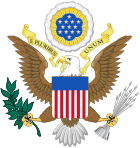



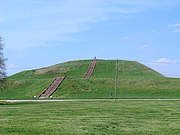

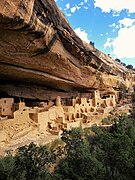

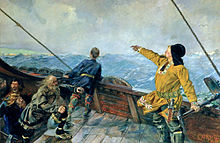



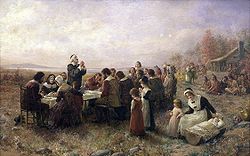



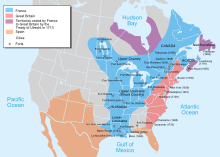
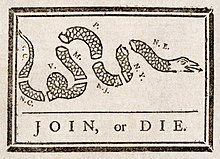
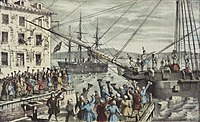
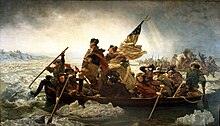






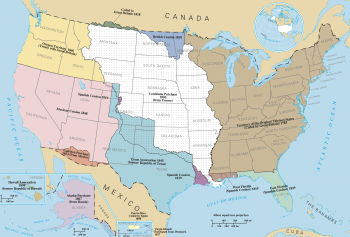












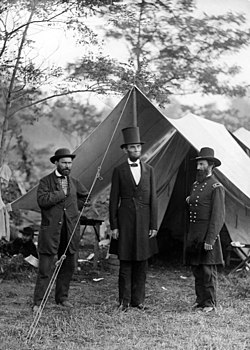









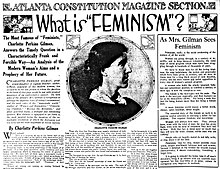


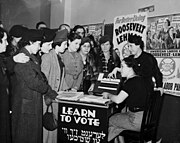


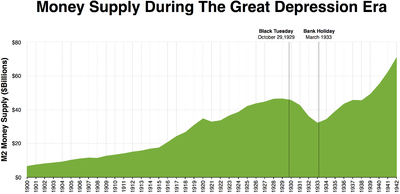



















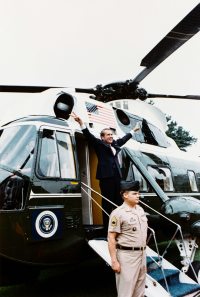


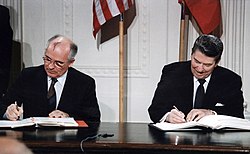

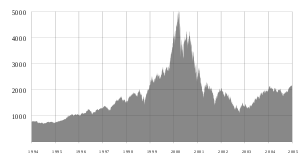
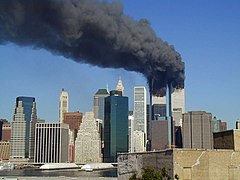











No comments:
Post a Comment